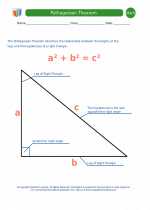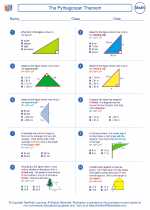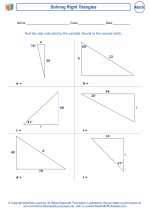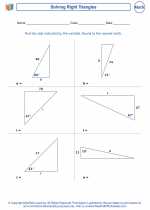The Pythagorean Theorem -> symmetry
Symmetry
Symmetry is a fundamental concept in mathematics and art. It refers to the balanced and harmonious arrangement of elements on either side of a dividing line or center point. In mathematics, we study different types of symmetry, including line symmetry, rotational symmetry, and point symmetry.
Types of Symmetry
- Line Symmetry: Also known as mirror symmetry, it occurs when an object can be divided into two equal halves, with one half being the mirror image of the other. The line of symmetry is the imaginary line along which the object can be folded to form two congruent parts.
- Rotational Symmetry: This type of symmetry occurs when a shape can be rotated by a certain angle (other than 360°) and still look the same. The smallest angle of rotation that preserves the shape's appearance is called the order of rotational symmetry.
- Point Symmetry: Point symmetry occurs when a shape looks the same after being rotated by 180 degrees around a central point. This is also known as "rotational symmetry of order 2."
Examples of Symmetry
Some common examples of symmetry include:
- A square has 4 lines of symmetry and 4-fold rotational symmetry.
- A circle has infinite lines of symmetry and infinite-fold rotational symmetry.
- The letter "X" has 2 lines of symmetry and 2-fold rotational symmetry.
Studying Symmetry
To understand symmetry better, it's important to practice identifying and creating symmetric figures. Here are some key points to remember while studying symmetry:
- Identify the lines of symmetry for different shapes, letters, and numbers.
- Determine the order of rotational symmetry for various shapes and patterns.
- Explore real-life examples of symmetry, such as architecture, nature, and art.
- Use graph paper to create symmetric designs and patterns.
Practice Questions
Test your understanding of symmetry with the following questions:
- How many lines of symmetry does the letter "H" have?
- What is the order of rotational symmetry for a regular hexagon?
- Find a real-life example of rotational symmetry in nature or man-made structures.
Remember, understanding symmetry is not only important in mathematics but also in various fields such as art, design, and architecture. Embracing symmetry can lead to a deeper appreciation of the beauty and balance in the world around us.
.◂Math Worksheets and Study Guides Seventh Grade. The Pythagorean Theorem

 Study Guide
Study Guide
 Worksheet/Answer key
Worksheet/Answer key
 Worksheet/Answer key
Worksheet/Answer key
 Worksheet/Answer key
Worksheet/Answer key
 Worksheet/Answer key
Worksheet/Answer key
 Worksheet/Answer key
Worksheet/Answer key
 Worksheet/Answer key
Worksheet/Answer key
 Worksheet/Answer key
Worksheet/Answer key
 Worksheet/Answer key
Worksheet/Answer key
 Worksheet/Answer key
Worksheet/Answer key
 Worksheet/Answer key
Worksheet/Answer key
